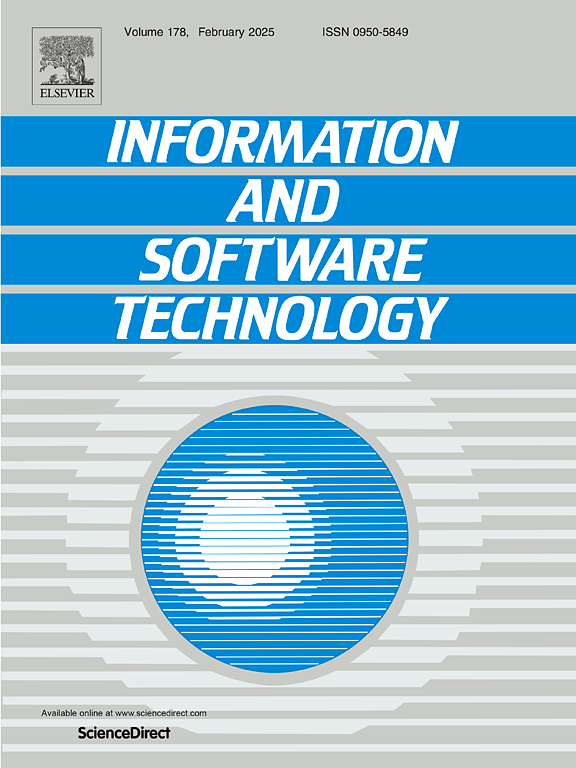Evaluating the understandability and user acceptance of Attack-Defense Trees: Original experiment and replication
IF 3.8
2区 计算机科学
Q2 COMPUTER SCIENCE, INFORMATION SYSTEMS
引用次数: 0
Abstract
Context:
Attack-Defense Trees (ADTs) are a graphical notation used to model and evaluate security requirements. ADTs are popular because they facilitate communication among different stakeholders involved in system security evaluation and are formal enough to be verified using methods like model checking. The understandability and user-friendliness of ADTs are claimed as key factors in their success, but these aspects, along with user acceptance, have not been evaluated empirically.
Objectives:
This paper presents an experiment with 25 subjects designed to assess the understandability and user acceptance of the ADT notation, along with an internal replication involving 49 subjects.
Methods:
The experiments adapt the Method Evaluation Model (MEM) to examine understandability variables (i.e., effectiveness and efficiency in using ADTs) and user acceptance variables (i.e., ease of use, usefulness, and intention to use). The MEM is also used to evaluate the relationships between these dimensions. In addition, a comparative analysis of the results of the two experiments is carried out.
Results:
With some minor differences, the outcomes of the two experiments are aligned. The results demonstrate that ADTs are well understood by participants, with values of understandability variables significantly above established thresholds. They are also highly appreciated, particularly for their ease of use. The results also show that users who are more effective in using the notation tend to evaluate it better in terms of usefulness.
Conclusion:
These studies provide empirical evidence supporting both the understandability and perceived acceptance of ADTs, thus encouraging further adoption of the notation in industrial contexts, and development of supporting tools.
评估攻击防御树的可理解性和用户接受度:原始实验和复制
背景:攻击防御树(ADT)是一种用于建模和评估安全需求的图形符号。ADT 很受欢迎,因为它便于参与系统安全评估的不同利益相关者之间进行交流,而且足够正规,可以使用模型检查等方法进行验证。方法:实验采用方法评估模型(MEM)来检查可理解性变量(即使用 ADT 的有效性和效率)和用户接受度变量(即易用性、有用性和使用意向)。MEM 还用于评估这些维度之间的关系。此外,还对两个实验的结果进行了对比分析。结果表明,ADT 被参与者很好地理解,可理解性变量的值大大高于既定的阈值。此外,ADT 还受到高度评价,尤其是其易用性。结论:这些研究为 ADT 的可理解性和感知接受度提供了实证支持,从而鼓励在工业环境中进一步采用 ADT 并开发辅助工具。
本文章由计算机程序翻译,如有差异,请以英文原文为准。
求助全文
约1分钟内获得全文
求助全文
来源期刊

Information and Software Technology
工程技术-计算机:软件工程
CiteScore
9.10
自引率
7.70%
发文量
164
审稿时长
9.6 weeks
期刊介绍:
Information and Software Technology is the international archival journal focusing on research and experience that contributes to the improvement of software development practices. The journal''s scope includes methods and techniques to better engineer software and manage its development. Articles submitted for review should have a clear component of software engineering or address ways to improve the engineering and management of software development. Areas covered by the journal include:
• Software management, quality and metrics,
• Software processes,
• Software architecture, modelling, specification, design and programming
• Functional and non-functional software requirements
• Software testing and verification & validation
• Empirical studies of all aspects of engineering and managing software development
Short Communications is a new section dedicated to short papers addressing new ideas, controversial opinions, "Negative" results and much more. Read the Guide for authors for more information.
The journal encourages and welcomes submissions of systematic literature studies (reviews and maps) within the scope of the journal. Information and Software Technology is the premiere outlet for systematic literature studies in software engineering.
 求助内容:
求助内容: 应助结果提醒方式:
应助结果提醒方式:


